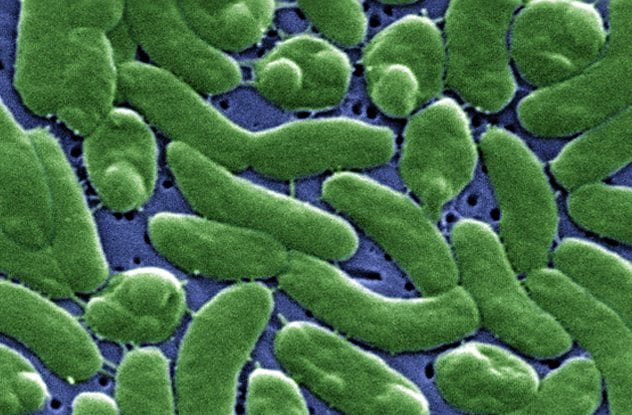 Animals
Animals  Animals
Animals  Facts
Facts Ten Unexpectedly Fascinating Facts About Rain
 Crime
Crime 10 Dark Details of Australia’s Gruesome Unsolved Wanda Murders
 Humans
Humans 10 Unsung Figures Behind Some of History’s Most Famous Journeys
 Animals
Animals 10 Species That Refused to Go Extinct
 Weird Stuff
Weird Stuff 10 Weird Things People Used to Do at New Year’s
 Our World
Our World 10 Archaeological Discoveries of 2025 That Refined History
 Weird Stuff
Weird Stuff 10 Fascinating Facts You Might Not Know About Snow
 Miscellaneous
Miscellaneous Top 10 Things Crypto Was Supposed to Change & What Actually Did
 History
History 10 Huge Historical Events That Happened on Christmas Eve
 Animals
Animals 10 Strange Times When Species Evolved Backward
 Facts
Facts Ten Unexpectedly Fascinating Facts About Rain
 Crime
Crime 10 Dark Details of Australia’s Gruesome Unsolved Wanda Murders
Who's Behind Listverse?

Jamie Frater
Head Editor
Jamie founded Listverse due to an insatiable desire to share fascinating, obscure, and bizarre facts. He has been a guest speaker on numerous national radio and television stations and is a five time published author.
More About Us Humans
Humans 10 Unsung Figures Behind Some of History’s Most Famous Journeys
 Animals
Animals 10 Species That Refused to Go Extinct
 Weird Stuff
Weird Stuff 10 Weird Things People Used to Do at New Year’s
 Our World
Our World 10 Archaeological Discoveries of 2025 That Refined History
 Weird Stuff
Weird Stuff 10 Fascinating Facts You Might Not Know About Snow
 Miscellaneous
Miscellaneous Top 10 Things Crypto Was Supposed to Change & What Actually Did
 History
History 10 Huge Historical Events That Happened on Christmas Eve
10 Horrifying Tales Of Flesh-Eating Diseases
The idea of being devoured alive by an unseen nemesis is the most terrifying thing imaginable. Not only do these diseases cause fevers, nausea, and excruciating pain; they disfigure their victims, sometimes beyond recognition. With all victims have to deal with, death can seem a blessing.
10Bairnsdale Ulcer

Bairnsdale ulcer is terrorizing Australia. It begins as a mosquito bite and soon spreads to gaping wounds that devour flesh, fat, tendons, nerves, and even bone. Epidemiologists believe it spreads to humans via mosquitoes on possums. They are uncertain whether the possums are the cause or just another victim. The disease incubates slowly, often emerging four months after the initial bite. The elbow, back, calf, and ankle are the most common areas targeted.
Bairnsdale ulcer has been known for decades. However, in the past three years, the number of cases in Australia has doubled. This year, Victoria has had 45 cases alone. Fortunately, a quick and effective test is available. If caught early, ulcers are easily treated. If not, it can lead to extreme pain and possibly amputation.
9Missouri’s Mucormycosis Outbreak

In 2011, a tornado ravaged Joplin, Missouri. The high winds carried more than destructive power. After the storm, several individuals were diagnosed with a rare and deadly flesh-eating fungal infection. Mucormycosis fungus is most commonly found in wood and soil and is a key component in the cycle of decay. The virulent fungus infects the walls of blood vessels. Filaments form, resulting in clots. The clots block blood flow, leading to necrosis of the flesh and even a coating of mold.
Known as a “lid-lifter,” the fungus grows so fast in lab environments it will literally lift the lid off a Petri dish. It grows just as fast in humans, eating into tissue and even bone. Only 74 cases of this disease had ever been recorded. 13 people in Joplin had the disease. Five died. The only treatment is powerful antifungal drugs and debridement, where dead flesh is sliced away.
8Diseased Deer

After being eradicated for nearly 30 years, screwworm flies have return to the Florida Keys. It’s victim: the endangered key deer. The deer currently have a population between 1,300 and 1,500. So far, 102 animals have been euthanized after developing untreatable infections. Screwworms lay eggs in broken skin, and their maggots feed on living flesh. All but seven of the infected deer have been bucks. With open wounds from fighting over females, they are more susceptible to infection.
Federal officials began to sterilize male flies on Big Pine and No Name Key, the worst affected areas. The strategy worked in the 1950s and 1960s, leading to an eradication of the disease in Florida. Biologists and volunteers have begun to feed the key deer food laced with doramectin, a powerful anti-parasitic drug.
7Aleppo Evil

Cutaneous leishmaniasis is a disfiguring disease spread by sand flies. Known as “Aleppo Evil,” the disease has been endemic to Syria for centuries. Horrible open sores emerge around the bite site. The disease can be deadly if left untreated or if it destroys the mucus membranes.
Once contained in Syria, the disease broke out in refugee camps in Lebanon in 2012. The disease is now found in Turkey, Lebanon, Jordan, and even southern Europe. The Kurdish Red Crescent reported that ISIS spread the disease by dumping festering bodies in the streets. The School of Tropic Medicines has refuted this primitive biological warfare claim. Sand flies feed on the living, not rotting corpses. The rise is due to a collapsed health care system.
6Eczema Herpeticum

Owen Richards, seven, developed eczema when he was just six weeks old. It began as redness on his cheek and soon spread to his legs and stomach. The condition worsened, leaving the boy covered in weeping, bloody sores. The eczema grew so bad that his family could not even hug him. The scratching and bleeding fits made even simple tasks like going to the bathroom and dressing an exercise in agony. Painful cysts developed under his fingernails.
In 2013, Owen was hospitalized with eczema herpeticum, a rare flesh-eating bacterial infection. It began looking like chicken pox, but within 24 hours, the flesh-eating disease began to devour his face. It looked like he suffered from burns. Owen was initially placed on intravenous antiviral drugs. However, fearing the impact of harsh treatment on the young boy, his mother soon explored herbal alternatives. Shulan Tang, a professor of Chinese medicine in Manchester, prescribed an herbal mixture. Within four weeks, Owen was healthy enough to run, play, and even attend school.
5Alabama Rot

Alabama Rot, also known as cutaneous and renal glomerular vasculopathy, was first spotted among greyhounds in the United States. The disease causes festering skin lesions and can lead to kidney failure if untreated. Dog owners are becoming terrified to take their pets anywhere.
The first case in the UK appeared in 2012. Since 2014, a full-blown outbreak has begun across all breeds and ages, with at least 78 cases since 2012. Lesions typically appear around the face, abdomen, and legs. These are followed by nausea, fatigue, high fever, and eventual renal failure. The origins of the disease are unknown. There is no evidence of virus, fungus, bacteria, or toxins. Some suspect that a rare form of E. coli bacteria might be the culprit.
4Necrotic Spider Bites

Brown recluse bites are rare. They are not aggressive and lack the ability to pierce clothing. Bites usually only occur when the arachnids are accidentally trapped against the skin. Even without treatment, most bites heal within three weeks. However, in some cases the venom destroys the surrounding tissue.
In 2013, Jeff Hanneman, the guitarist from shred-metal band Slayer, died of liver failure. Nearly every news outlet reported that he died from complications of necrotizing fasciitis he received from a spider bite in 2010. It took several operations to remove the dead tissue. He was even placed in a medically induced coma and had to learn to walk again. A coroner ruled alcohol-induced cirrhosis was the culprit. It is likely that this liver disease preceded the spider bite.
3Sepsis’s Second Act

In 2012, John Middleditch thought he had the flu. A purple rash spread across his body. His limbs turned black and filled with fluid. Multiple internal organs failed. The diagnosis was sepsis. His forearms and both legs were amputated. Against the odds, the quadruple amputee survived. Doctors fitted him with prosthetic limbs, and Midleditch was even back at his beloved gardening.
Four years later, the disease struck again. Within weeks, Middleditch was dead.
44,000 people die of sepsis each year in the UK alone. It is more common than heart attacks and kills more people per year than cancer. Also known as “blood poisoning,” the condition is almost always triggered by another common infection. The body overreacts, and the immune system devours tissue and organs.
2Buruli Ulcer

Buruli ulcer is spreading across West Africa. So far, this flesh-eating disease has infected 40,000 people. It leaves its victims with festering wounds and swollen ulcers. In extreme cases, amputation is needed. Experts are uncertain how the disease spreads. Most suspect contact with an opening in the skin.
A huge number of West African cases go unreported because of illiteracy, poverty, and reliance on traditional healing techniques. Many sufferers believe they are under the influence of witchcraft. The World Health Organization reports that a vaccine offers short term defense against the bacteria that causes the disease, Mycobacterium ulcerans. Long-term vaccines and effective diagnosis techniques are in the works.
1Chesapeake Killer

On September 11, 2016, Michael Funk was cleaning crab pots in the Chesapeake Bay. Four days later, he was dead. A flesh-eating bacteria known as Vibrio vulnificus devoured him alive. He soon fell ill with ferocious pain in his legs and was hospitalized. A doctor removed dead tissue, but the disease spread to his bloodstream. There was nothing anyone could do.
Vibrio bacteria thrive in warm, coastal waters with low salinity. There are 85,000 cases per year in the United States. Eating tainted crabs and fish is the most common mode of infection. Funk contracted his infection through a cut in his leg. There may be pressure from the tourist industry to downplay the significance of these flare-ups.
Abraham Rinquist is the executive director of the Winooski, Vermont, branch of the Helen Hartness Flanders Folklore Society. He is the coauthor of Codex Exotica and Song-Catcher: The Adventures of Blackwater Jukebox.








